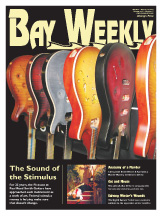Chesapeake Bay's Independent Newspaper ~ Since 1993
1629 Forest Drive, Annapolis, MD 21403 ~ 410-626-9888
Volume xviii, Issue 9 ~ March 4 - March 10, 2010
Home \\ Correspondence \\ from the Editor \\ Submit a Letter \\ Classifieds \\ Contact Us
Best of the Bay \\ Dining Guide \\ Home & Garden Guide \\ Archives \\ Distribution \\ Advertising![]()


Seasons on the Wing
The birds we love best come — and go
If you read the seasons in bird life, you’re at a chapter-turning point right now.
Slowly melting are the mountains of February snow that brought every bird in the woods out to eat at your feeder.
Safflower and black sunflower seed, both broadcast and in feeders, were the main draws at my house, along with suet and thistle seed. In to gobble it up flew enough cardinals to take on the white-throated sparrows on the baseball field, plus chickadees, titmice (or is it mouses?), juncos, lots of male and female red-winged blackbirds, restless flights of grackles, starlings and maybe a cowbird or two. The stars of the show were a pair of rufous-sided towhees as useful as they were beautiful, digging holes in the snow where other birds could follow them in seeking lost seeds.
Robins and one brown thrasher came late to scratch around in the husk-littered snow. Woodpeckers showed up for the suet and finches for the thistle. Both the gold and house finches were starting to color for spring.
That shouldn’t have surprised me. Even as winter behaved at its worst and wind whipped the birds’ feathers into froth, the occasional heron glided out of pterodactyl flight to stalk marsh edges. Herons keep a Valentine’s Day date in Chesapeake Country, returning to rookeries high in guano-killed trees to nest and mate. So spring is in the air even when winter is on the ground.
Fairhaven’s little marsh lake has been busy all winter, so heron joins a crowd of dabblers. Flocks of black ducks and mallards have fed there all winter, butts in the air as they graze the shallow bottom. That’s a funny sight, but it’s topped by the bigger butts and black feet of tundra swans, annual winter visitors to the marsh lake. Canada geese come and go on this lake, too.
When the lake freezes, the black, gray and white flocks move onto Herring Bay, where the shallows stretch for hundreds of feet so there’s clear water beyond the ice.
The cattails around the lake’s edge are where the red-winged blackbirds live. They must not mind the cold, because they’re the first flight of spring in my part of Chesapeake Country.
We know the swans don’t mind the cold. We’re their Florida. They’ve been warming up with us since November. Now they’re noisily talking about flying back to the Canadian tundra that’s their summer home. They and the geese, too, will go before the osprey sail in.
St. Patrick’s Day is the date the osprey keep, and already human neighbors are talking about their arrival. A usually reliable source reports hearing their shrill whistle February 27. That would be the whistle of an early bird. Osprey researcher Rob Bierregaard ([email protected]) of the University of North Carolina expects his transmitter-tagged males to head north in February or March.
Whenever our osprey arrive, in stages over several weeks, they’ll have thousands of miles under their wings. Our March-to-September osprey spend the other half of the year down south, anywhere from Cuba to South America.
We’re not the only ones looking out for that flying seasonal marker. Queries on bird stories started flying my way this week as people hurry the season like the birds do.
We all like to think of ourselves in sympathy with the birds. But one of the week’s queries proves it’s not always so. A woman from Solomons called almost in tears to report the killing of a fellowship of swans she and her neighbors had come to love. They were mute swans, illegal European immigrants who’ve naturalized after escaping from ornamental ponds. They and all their kind are under a death sentence from Maryland Department of Natural Resources.
Perhaps it’s so that the birds we love are the ones that come — and go.
© COPYRIGHT 2010 by New Bay Enterprises, Inc. All rights reserved.
